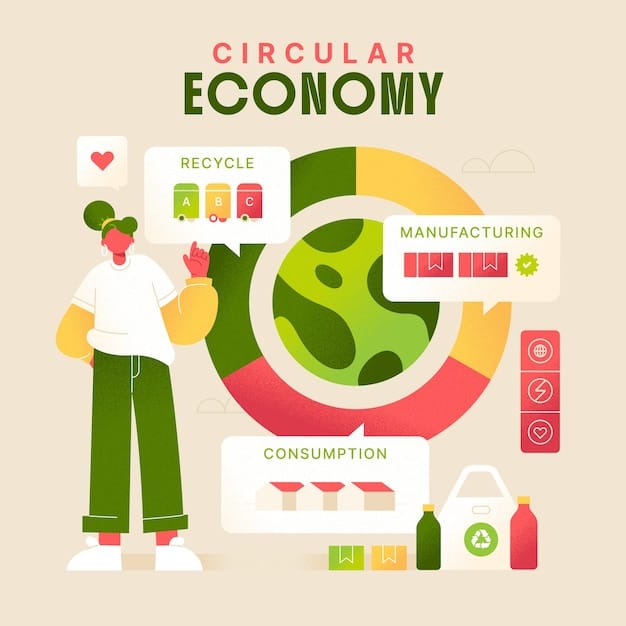The ‘Deinfluencing’ Trend: How Social Media is Changing Consumerism

The ‘deinfluencing’ trend on US social media promotes mindful consumption by encouraging users to question popular products and prioritize needs over wants, suggesting a shift towards a more conscious consumer culture.
Have you noticed a shift in your social media feeds? The rise of the ‘deinfluencing’ trend on US social media is prompting many to rethink their shopping habits. This movement challenges traditional consumerism, encouraging a more mindful approach to purchasing decisions.
What is the ‘Deinfluencing’ Trend?
The ‘deinfluencing’ trend is a counter-movement gaining traction on social media platforms, particularly in the US. It involves content creators actively discouraging excessive consumerism and promoting more thoughtful purchasing decisions. Instead of showcasing a constant stream of new products, these ‘deinfluencers’ often highlight the downsides of certain items, suggest alternatives, or encourage viewers to make use of what they already own.
This trend isn’t about simply bashing products; it’s about fostering a more realistic and critical perspective on the constant barrage of advertising and promotion that dominates social media. It questions the pervasive culture of needing the latest and greatest items and encourages consumers to consider the environmental, financial, and emotional impact of their purchases.
The Core Principles of Deinfluencing
At its heart, deinfluencing is about shifting the power dynamic between influencers and their audience. It’s about transparency, honesty, and a genuine desire to help viewers make informed choices. Here are a few core principles that characterize this movement:
- Honest Reviews: Deinfluencers provide unbiased reviews, highlighting both the pros and cons of products, even those that are heavily promoted.
- Challenging Hype: They question the excessive hype surrounding viral products and trends, encouraging viewers to think critically about whether they truly need an item.
- Promoting Sustainability: Many deinfluencers advocate for sustainable consumption, encouraging viewers to buy less, buy better, and take care of what they already own.
- Financial Awareness: They emphasize the importance of financial responsibility, discouraging impulse purchases and promoting budget-friendly alternatives.
Ultimately, the ‘deinfluencing’ trend seeks to empower consumers to be more discerning and less susceptible to the pressures of social media marketing.
The Rise of Anti-Hauls and Critical Reviews
One of the most visible manifestations of the ‘deinfluencing’ trend is the rise of “anti-hauls” and critical reviews. Unlike traditional haul videos that showcase a large number of newly purchased items, anti-hauls highlight products that creators are actively avoiding and explain why.
These videos often focus on overhyped or overpriced items, products with questionable ingredients or ethical concerns, or simply things that the creator doesn’t believe are worth the money. Critical reviews, on the other hand, offer a more in-depth analysis of specific products, pointing out flaws or limitations that are often glossed over by traditional influencers. These anti-hauls are important because they shed light on a product’s worth.

Examples of Successful Anti-Haul Content
Many creators have found success creating anti-haul content about products that have been reviewed extensively. Here are some common themes:
- Questioning Product Claims: Deinfluencers often challenge the marketing claims made by brands, putting products to the test and reporting on whether they live up to the hype.
- Pointing Out Hidden Costs: They highlight hidden costs associated with certain products, such as subscription fees, replacement parts, or the need for additional accessories.
- Suggesting Alternatives: Deinfluencers frequently suggest alternatives to popular products, whether it’s a more affordable option, a more sustainable choice, or simply something that they believe is better quality.
- Highlighting Red Flags: They bring attention to potential red flags, such as negative reviews from other consumers, ethical concerns about the brand, or ingredients that may be harmful.
By providing viewers with a more balanced perspective, anti-hauls and critical reviews empower them to make more informed purchasing decisions and avoid falling prey to marketing hype.
The Impact on Traditional Influencer Marketing
The ‘deinfluencing’ trend is undoubtedly having an impact on traditional influencer marketing. As consumers become more aware of the potential for bias and manipulation, they are increasingly seeking out more authentic and trustworthy sources of information. This shift in consumer behavior is forcing brands and influencers alike to re-evaluate their strategies.
Brands are now understanding that consumers are savvy and skeptical. It is difficult to gain their trust if influencers are not transparent. The traditional mode of “everything is great” is less effective, and influencers who deliver honest assessments of a product may be able to thrive more than the “rah rah” influencers of the past.
How Influencers Are Adapting
Some influencers are adapting to the ‘deinfluencing’ trend by incorporating more honesty and transparency into their content. This might involve disclosing sponsored posts more clearly, providing more balanced reviews, or even occasionally recommending against purchasing certain products. Other influencers are choosing to focus on niche topics that they are genuinely passionate about, building a loyal following based on expertise and authenticity.
- Increased Transparency: Influencers are becoming more transparent about sponsored content and affiliate links, ensuring that viewers understand when they are being paid to promote a product.
- Focus on Value: Many influencers are shifting their focus from simply showcasing products to providing valuable content, such as educational tutorials, informative reviews, or entertaining lifestyle content.
- Building Trust: Influencers are prioritizing building trust with their audience by being honest, authentic, and responsive to feedback.
- Diversifying Content: Some influencers are diversifying their content beyond product reviews, exploring broader topics related to their niche, such as sustainability, ethical consumption, or personal finance.
While the ‘deinfluencing’ trend may present challenges for some influencers, it also creates opportunities for those who are willing to adapt and embrace a more authentic approach.
Is This a Sign of Changing Consumer Values?
The ‘deinfluencing’ trend raises important questions about changing consumer values in the US. Does it signify a growing disillusionment with consumer culture, or is it simply a passing fad? While it’s difficult to predict the future, several factors suggest that this trend may reflect a deeper shift in attitudes towards consumption.
Consumers, particularly younger generations, are increasingly concerned about the environmental and social impact of their purchases. They are also more likely to be financially conscious, prioritizing experiences over material possessions and seeking out value-driven brands. These factors, combined with the growing awareness of the manipulative potential of influencer marketing, are contributing to a more critical and discerning consumer base.

Factors Driving the Shift
Several factors are fueling the rise of ‘deinfluencing’ and the shift toward more conscious consumption:
- Increased Awareness of Environmental Issues: Consumers are becoming more aware of the environmental impact of their purchases, from carbon emissions to waste generation.
- Growing Concerns About Social Justice: Many consumers are seeking out brands that align with their values, supporting companies that prioritize fair labor practices, ethical sourcing, and social responsibility.
- Financial Instability: Economic uncertainty is leading many consumers to be more cautious about their spending, prioritizing needs over wants and seeking out affordable alternatives.
- Skepticism Towards Advertising: Consumers are increasingly skeptical of traditional advertising and influencer marketing, seeking out more authentic and trustworthy sources of information.
Whether the ‘deinfluencing’ trend represents a fundamental shift in consumer values or a temporary reaction to current economic and social conditions remains to be seen. However, it is clear that consumers are demanding more from brands and influencers, seeking out authenticity, transparency, and a genuine commitment to social and environmental responsibility.
The Role of Social Media Algorithms
Social media algorithms play a significant role in shaping the ‘deinfluencing’ trend. These algorithms, designed to promote engagement and keep users on the platform for longer, can amplify certain types of content and suppress others. In the case of ‘deinfluencing’, algorithms can help to spread the message of mindful consumption by surfacing anti-haul videos, critical reviews, and content that challenges traditional marketing narratives.
However, algorithms can also create echo chambers, reinforcing existing beliefs and limiting exposure to diverse perspectives. It’s important to be aware of the potential for algorithmic bias and to actively seek out a variety of voices and viewpoints on social media.
How Algorithms Impact Content Visibility
Social media algorithms use a variety of factors to determine which content to show to users. Here are some of the key factors that can impact the visibility of ‘deinfluencing’ content:
- Engagement: Content that generates high levels of engagement, such as likes, comments, and shares, is more likely to be shown to a wider audience.
- Relevance: Algorithms prioritize content that is relevant to a user’s interests and browsing history.
- Recency: Newer content is often given preference over older content.
- Source: Content from trusted sources and verified accounts may be given higher priority.
By understanding how algorithms work, content creators can optimize their content to increase its visibility and reach a wider audience. This might involve using relevant hashtags, engaging with their audience, and creating content that is both informative and entertaining.
The Future of Consumerism on Social Media
The ‘deinfluencing’ trend is likely to continue shaping the future of consumerism on social media. As consumers become more discerning and algorithms evolve, brands and influencers will need to adapt their strategies to remain relevant and build trust with their audience. This could involve prioritizing authenticity, transparency, and a genuine commitment to social and environmental responsibility.
The future of consumerism on social media may also involve a greater emphasis on community and collaboration. Brands could partner with influencers to create content that is co-created with their audience, fostering a sense of ownership and engagement. Influencers could also collaborate with each other to share resources, promote each other’s content, and build a stronger collective voice.
| Key Point | Brief Description |
|---|---|
| 🚫 Challenging Hype | Questioning overhyped products and urging critical thinking. |
| 🌱 Promoting Sustainability | Encouraging less consumption and sustainable choices. |
| 💰 Financial Awareness | Emphasizing responsible spending and budget-friendly options. |
| ⭐ Honest Reviews | Providing unbiased assessments, highlighting pros and cons. |
Frequently Asked Questions
▼
‘Deinfluencing’ is a social media trend where creators discourage excessive consumerism by highlighting product flaws or suggesting viewers avoid unnecessary purchases to promote thoughtful spending.
▼
It requires influencers to be more transparent and honest. They may need to adapt by providing balanced reviews or focusing on expertise and value, rather than just promoting products.
▼
Anti-haul videos resonate with consumers seeking genuine opinions, providing rationales for avoiding certain products, challenging hype, and advocating smarter purchasing decisions.
▼
Its longevity depends on whether it reflects evolving consumer values—such as sustainability, financial awareness, and skepticism—or if it’s a short-term response to particular conditions.
▼
Algorithms can amplify ‘deinfluencing’ content through engagement and relevance or hinder it by creating echo chambers. Creators need to optimize content and encourage diversity for reach.
Conclusion
The ‘deinfluencing’ trend on US social media represents a potential shift in consumer behavior, urging a more mindful and critical approach to purchasing decisions. While its long-term impact remains to be seen, it’s clear that consumers are seeking greater authenticity and transparency from brands and influencers alike. This shift presents both challenges and opportunities for the marketing landscape, potentially leading to a more responsible and sustainable model of consumerism.





